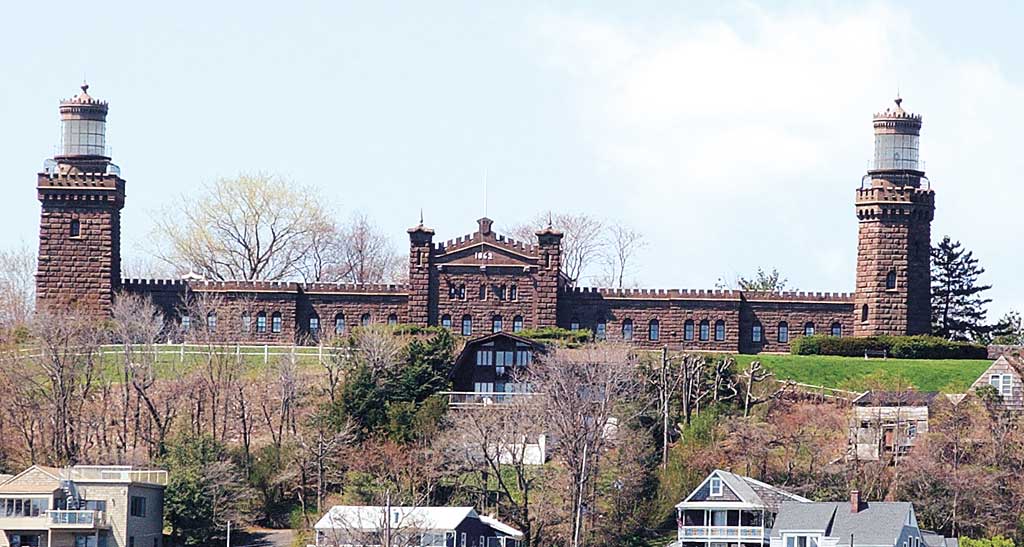HIGHLANDS — Friends and supporters of the Twin Lights Historical Society recently gathered to mark the 123rd anniversary of the day the Pledge of Allegiance was given as America’s national oath of loyalty for the first time.
In an April 25 ceremony held in front of the iconic Twin Lights lighthouse, state, county and local officials gathered to recall the historic 1893 reading of the Pledge and to participate in a ribbon-cutting ceremony for the Twin Lights Museum.
Monmouth County Sheriff Shaun Golden led the crowd in reciting two versions of the Pledge — the one given by Francis Bellamy and young members of the Lyceum League at the lighthouse in 1893 and the current version, which has been unchanged since 1954.
Golden was accompanied by a group of schoolchildren from The Rumson Country Day School, where the Pledge is recited each morning. Bellamy had originally written the Pledge of Allegiance for students to recite during an 1892 Columbus Day celebration.
John Trontis, assistant director of the State Park Service, sang “The Star-Spangled Banner.” A color guard from the U.S. Coast Guard Station Sandy Hook participated in the ceremony, which took place against the backdrop of an 18-foot flag on the side of the lighthouse.
Speakers at the event included state Sen. Joe Kyrillos, Monmouth County Freeholders Tom Arnone, John Curley and Lillian Burry, museum designer John Williams, Dr. Peter Keim, an authority on the history of the American flag, Mary Jo Kenny, president of the Twin Lights Historical Society and Richard Boornazian, assistant commissioner of Natural and Historic Resources, who spoke on behalf of Gov. Chris Christie.
The speaker’s podium was positioned in front of the Twin Lights’ 1756 “Mystery Cannon” — the most-photographed piece of artillery in the state, according to the press release.
Boornazian described the Twin Lights as one of the state’s premier historic sites. Arnone echoed his sentiments, adding that heritage tourism in Monmouth County is an important economic engine, and that the Twin Lights — with 75,000-plus visitors a year — is a key part of that picture. He invited fellow freeholders to the podium to read a proclamation setting aside April 25 as “Twin Lights Museum Day.”
“When we look at this edifice behind us, it is truly the face of Monmouth County and the face of New Jersey because this is where our history rests. This was the beacon that brought so many people to our shores,” said Curley.
“I’ve often said you don’t know where you’re going unless you know where you’ve been,” said Burry. “It’s important to recognize exactly what this building symbolizes to us all.”
Williams recounted details of the three-year museum renovation project (which was officially completed with the ribbon-cutting) and the challenges of mounting the Seeing Stars exhibit, which is scheduled to run through the end of the year.
“The State of New Jersey, and surrounding community, is lucky to have an organization like the Twin Lights Historical Society,” said Williams. “To plan, to assemble and to finally execute an exhibit of this quality is a testament to the commitment to excellence by its leadership. It’s clear to me that this is a small, but mighty organization.”
Numerous roadblocks delayed the renovation, Williams added, admitting that he began to wonder if the new museum and Seeing Stars would happen.
“It is not uncommon that a friends group such as this one exhausts all of its resources, or loses the patience to move forward,” he pointed out. “But not this group. They succeeded in putting together an exhibit on the American flag that [makes] every American proud.”
Kyrillos congratulated the Society on its “extraordinary feat” and called the Twin Lights a “touchstone destination.”
The morning’s final speaker, Dr. Keim, talked about the Seeing Stars exhibit, which features some of the gems from his personal collection — including a 13-star flag, a cavalry guidon carried into battle by the famous Buffalo Soldiers and an 1876 folk art statue of Uncle Sam— as well as patriotic artifacts from the collection of the Monmouth County Historical Association, stretching from the Civil War to World War II.
“This exhibit is going to help you understand why you feel the way you do about the American flag,” he said. “It’s the fabric of our nation … and there is no better place to tell the story of our flag than where we first pledged allegiance to it.”

